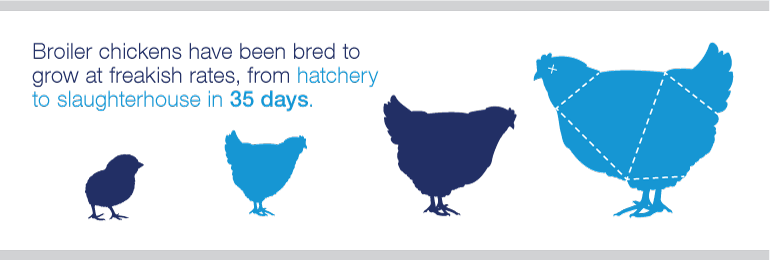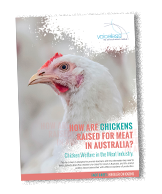
Chicken factory farms are “intensive, highly mechanised units that occupy relatively small areas compared with conventional farming.”4 They aim to produce the most amount of meat from broiler chickens in the shortest time and for the least cost – an approach that is at odds with animal welfare.5
Getting to know chickens
Chickens are sentient animals experiencing a range of emotions including pain, fear, anxiety, boredom, frustration, discomfort and distress.6
They naturally live in small, relatively stable communities, and form complex social relationships with fellow chickens within those communities.7 In recent years, scientists have learned chickens possess surprising emotional, intellectual and social complexity. Chickens can:
- possess communication skills on par with some primates.
- be deceptive and cunning.
- use sophisticated signals to convey their intentions.8
- solve complex problems, empathise with individuals that are in danger.9
- recognise 100 individuals of their kind.10
Factory Farming conditions
About 90% of chickens in Australia are raised in intensive factory farms.17 Current industry codes allow broiler chickens to be stocked at densities as high as 20 birds per square metre.11 This leaves each fully grown broiler chicken with personal space approximately the size of an A4 page.12
High stocking densities have been shown to cause a number of welfare concerns for broiler chickens, including increased rates of mortality, diseases (such as breast blisters, chronic dermatitis and leg disorders), reduced walking ability and behavioural activity, and disturbed resting patterns.13
Broiler chickens are subjected to artificial lighting for long periods to increase feeding time and productivity, and to control aggression (resulting from high stocking density).14
Standing on a floor increasingly comprised of their own faeces15 unable to see sunlight and lacking personal space, broiler chickens are kept in intensive conditions experience various issues that compromise their welfare. They are not able to perform some of their most fundamental behaviours such as roosting and nurturing their young.16
Selective breeding
In 1975 it took approximately 64 days for a chicken to reach slaughter weight. Now, due to selective breeding techniques used by the chicken meat industry to efficiently produce higher quantities of meat, a broiler chicken can be ready for slaughter in just 35 days.18
Rapid body growth can cause all sorts of problems for factory farmed chickens. Some grow so big that their legs are unable to support their own body weight. They may suffer broken bones, swollen joints and spinal damage, causing pain. Bone weakness often results in degenerative diseases, with increasing pain and discomfort as chickens grow. This also makes chickens more likely to suffer fractures when they become agitated or when they are moved.19

The fast growth rate puts enormous pressure on their heart and lungs, causing acute heart failure in millions of chickens every year, known as ‘ascites’. Chickens may also suffer from Sudden-Death-Syndrome (SDS). SDS is characterised by sudden rigorous wing flapping, muscle contractions, loss of balance, vocalisations and, in the final stages, the birds collapsing on their backs or their side to die.20
The law
In Australia, there are State and Territory animal welfare laws21 that purport to protect animals but in reality, the fundamental interests of most farm animals, including those of meat chickens, are not protected by law.
National Model Codes of Practice apply in addition to some animal welfare laws; however, these Codes also fail to provide true protection and are often used to justify current practices.22 The current Model Code of Practice for the Welfare of Animals: Domestic Poultry (version 4) (the Poultry Code) is no exception.
Consumers are beginning to understand the welfare issues associated with chickens raised for meat. Recent surveys show that 78% of Australians support the need for broiler chickens to have access to the outdoors, and 75% support laws requiring chickens to be provided with enough space to exhibit their natural behaviours.23
Despite this consumer sentiment, it is estimated that only 10% of meat chickens are raised in conditions where they are given access to the outdoors.
Learn more
To learn more about the animal welfare issues in the chicken meat industry, read our fact sheet ‘How are Chickens Raised for Meat in Australia?’
- Access a detailed list of resources exploring factory farming and the law in Australia here.
Last updated September 2018
- 1. Australian Chicken Meat Federation (ACMF), ‘Industry Facts and Figures: Chicken Meat Production in Australia’ <http://www.chicken.org.au/page.php?id=4>.
- 2. ACMF, ‘Growing Meat Chickens’ (2011) <http://www.chicken.org.au/page.php?id=6>.
- 3. Ibid.
- 4. Ibid.
- 5. See for example Scientific Committee on Animal Health and Animal Welfare (SCAHAW), European Commission: Brussels, The Welfare of Chickens Kept for Meat Production (Broilers) Report No. SANCO.B3/AH/R15/2000 (2000), 11 <http://ec.europa.eu/food/fs/sc/scah/out39_en.pdf >.
- 6. D B Morton, ‘Does Broiler Welfare Matter, and to Whom?’ in Claire Weeks and Andrew Butterworth (eds), Measuring and Auditing Broiler Welfare (CABI Publishing, 2004) 242, 246-247.
- 7. Joy A Mench and Linda J Keeling, ‘The Social Behaviour of Domestic Birds’ in Linda J. Keeling and Harold W. Gonyou (eds), Social Behaviour in Farm Animals (CABI Publishing, 2001), 178-179; Michael C Appleby, Joy Mench and Barry O Hughes, ‘Chapter 5: Living in groups’ Poultry Behaviour and Welfare (CABI Publishing, 2004), 71.
- 8. Carolynn L. Smith and Sarah L. Zielinski, ‘The Startling Intelligence of the Common Chicken’ Scientific American 310(2).
- 9. Ibid.
- 10. Joy A Mench quoted in Michael Specter, ‘The Extremist,’ The New Yorker, 64 <http://www.michaelspecter.com/2003/04/the-extremist/>.
- 17. Based on 2011 estimates by Free Range Egg and Poultry Australia Ltd (FREPA), ‘FREPA Accredited Farms: Some facts and figures’ (2011) <http://www.frepa.com.au/frepa-accredited-farms-some-facts-and-figures/>.
- 11. Space allowance varies based on the weight of the chicken and the state or territory in which the bird is located. The figure is based on the Model Code of Practice for the Welfare of Animals – Poultry, (4th edition) (2002) (the Poultry Code), paragraphs 2, 3 and Appendix 2. The Poultry Code permits stocking densities of 28kg/m2 for non-mechanically ventilated systems and 40kg/m2 for mechanically ventilated systems. The figure assumes a slaughter weight of just under 2kg per bird.
- 12. This statement is based on the assumption of 20 two kilogram birds being kept per square meter, averaging 500 cm2 per bird for meat chickens. An A4 page, with sides of 21.0 cm x 29.7 cm, has an area of 623.7 cm2.
- 13. SCAHAW, ibid n 5, 66.
- 14. H A Olanrewaju et al, ‘A Review of Lighting Programs for Broiler Production’ (2006) 5(4) International Journal of Poultry Sciences, 302; Gerry Bolla, NSW Department of Primary Industries, PrimeFacts: Lighting of Poultry (April 2007) <http://www.dpi.nsw.gov.au/__data/assets/pdf_file/0007/212974/Lighting-of-poultry.pdf>.
- 15. Growers use an “all in/all out” system which means that floors of sheds are not cleaned for the duration of the lives of a group of chickens: ACMF, ibid n 2.
- 16. Personal communication with Carole de Fraga, Regional Representative, Compassion in World Farming, 19 September 2008 and 14 October 2008.
- 18. Australian Chicken Meat Federation Inc., Industry Facts and Figures: Efficiency of Chicken Meat in Australia (2011) <http://www.chicken.org.au/page.php?id=4.>.
- 19. See, for example, Scientific Committee on Animal Health and Animal Welfare (SCAHAW), European Commission: Brussels, The Welfare of Chickens Kept for Meat Production (Broilers) Report No. SANCO.B3/AH/R15/2000 (2000) available at <http://ec.europa.eu/food/fs/sc/scah/out39_en.pdf >. Unfortunately no such report has been commissioned in Australia and the practices of most growers are hidden behind closed doors.
- 20. Based on the estimate that up to 0.5% of Australia’s 550 million chickens are affected by Sudden Death Syndrome (SDS). This figure is a conservative estimate based on the reported incidence of between 0.1 and 3% for SDS in Europe: Ibid, p. 41.
- 21. Prevention of Cruelty to Animals Act 1986 (Vic); Prevention of Cruelty to Animals Act 1979 (NSW); Animal Care and Protection Act 2001 (Qld); Animal Welfare Act 2002 (WA); Animal Welfare Act 1985 (SA); Animal Welfare Act 1993 (Tas); Animal Welfare Act 1992 (ACT); Animal Welfare Act 1999 (NT).
- 22. Compliance with a code of practice may be used as a defence to a charge of animal cruelty or evidence to counter a charge of animal cruelty under most state legislation. See, for example, Prevention of Cruelty to Animals Act 1979 (NSW), s 34A; Animal Care and Protection Act 2001 (Qld), ss 16, 38 and 40; Animal Welfare Act 1985 (SA), s 43; Prevention of Cruelty to Animals Act 1986 (Vic), s 6; Animal Welfare Act 2002 (WA), s 25; Animal Welfare Act 1999 (NT), s 79.
- 23. Humane Research Council, ‘Animal Tracker Australia: Baseline Survey Results’ (June 2014), <https://voiceless.org.au/wp-content/uploads/2020/03/Animal-Tracker-Australia-Baseline-Report-June-2014-FINAL.pdf>.

